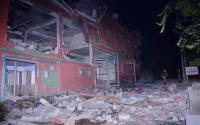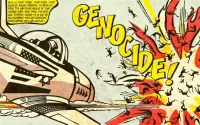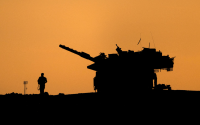Common Dreams / Published on Tuesday, June 3, 2003 by the Inter Press Service
When all three major U.S. newsweeklies--Time, Newsweek and U.S. News & World Report--run major features on the same day on possible government lying, you can bet you have the makings of a major scandal.
And when the two most important outlets of neo-conservative opinion--The Weekly Standard and The Wall Street Journal--come out on the same day with lead editorials spluttering outrage about suggestions of government lying, you can bet that things are going to get very hot as summer approaches in Washington.
The controversy over whether the administration of President George W. Bush either exaggerated or lied about evidence that it said it had about the existence of weapons of mass destruction (WMD) in Iraq before the U.S.-led invasion has mushroomed over the past week.
"This is potentially very serious," said one Congressional aide. "If it's shown we went to war because of intelligence that was 'cooked' by the administration, heads will have to roll--and not just little heads, big ones."
The administration was already on the defensive last week as the controversy took off in Europe, particularly in Britain where Prime Minister Tony Blair found himself assailed from all directions for either wilfully exaggerating the intelligence himself or being "suckered," as his former foreign minister Robin Cook called it this weekend, by Washington's neo-conservative hawks, who started agitating for war even before the dust settled in lower Manhattan after the Sep. 11, 2001 terrorist attacks.
Matters took a turn for the worse when the London Guardian reported Saturday about the existence of a transcript, obviously leaked from a senior British official, of an exchange at the Waldorf Hotel in New York between U.S. Secretary of State Colin Powell and British Foreign Minister Jack Straw just before Powell's presentation of the evidence against Iraq before the United Nations Security Council Feb. 5.
It quotes Powell, whose forceful case to the Council was decisive in persuading U.S. public opinion that Baghdad represented a serious threat, as being "apprehensive" about the evidence presented to him by the intelligence agencies. He reportedly expressed the hope that the actual facts, when they came out, would not "explode in their faces." (At a Rome press conference Monday, Powell insisted that he considered the evidence "overwhelming" when he spoke before the Council.)
But it appears that Powell's musing was accurate, as, after almost two months in uncontested control of Iraq, U.S. troops and investigators have failed to come up with concrete evidence of an Iraqi WMD program, let alone an actual weapon.
The scenario of an uneasy Powell received a major boost in the accounts of the three newsweeklies. U.S. News reported, for example, that, during a rehearsal of Powell's presentation at CIA headquarters Feb. 1, the normally mild-mannered retired general at one point ''tossed several pages in the air. 'I'm not reading this,' he declared. 'This is bull----'."
The same magazine also reported that the Defense Intelligence Agency (DIA) formally concluded that, "There is no reliable information on whether Iraq is producing and stockpiling chemical weapons" in September 2002, just as Pentagon chief Donald Rumsfeld was telling Congress that the Baghdad "regime has amassed large, clandestine stockpiles of chemical weapons, including VX, sarin, cyclosarin and mustard gas."
The accounts by Newsweek and Time were similarly damning. One "informed military source" told Newsweek that when the U.S. Central Command (CENTCOM) asked the CIA for specific WMD targets that should be destroyed in the first stages of the invasion, the agency only complied reluctantly.
But what it provided "was crap," a CENTCOM planner told the magazine, consisting mainly of buildings that were bombed in the first Gulf War in 1991. And agency experts reportedly could not tell the war-planners what agents were located where.
If true, that contradicts a series of bald assertions by administration officials and their supporters over the last nine months. "Simply stated," Vice President Dick Cheney declared in the first call to arms last August, "there is no doubt that Saddam Hussein now has weapons of mass destruction."
"We know where (the WMD) are," declared Rumsfeld in a television interview Mar. 30, well into the first week of the war. "They're in the area around Tikrit and Baghdad and east, west, south and north somewhat."
He has since retreated from that certainty, suggesting last week that the Iraqis "may have had time to destroy them, and I don't know the answer."
There is also growing doubt about the evidence that Bush himself touted this weekend as proof--two truck trailers described by officials as mobile weapons-productions labs.
According to a CIA report noted in the 'Slate' Internet magazine, key equipment for growing, sterilizing and drying bacteria was not present in either trailer. Iraqi officials have said the trailers were used to produce hydrogen for artillery weather balloons.
Matthew Meselson, a Harvard University expert on biological weapons who 20 years ago single-handedly debunked reports by senior Reagan administration officials--several of whom hold relevant positions in the Bush government--about the use by Soviet allies of mycotoxins against rebels in Laos and Afghanistan, has also expressed doubts about the trailers' purpose, and called for the CIA to hand over the evidence to independent scientists to make an assessment.
Retired intelligence officials from both the CIA and the DIA are also coming out with ever-stronger statements accusing the intelligence community of twisting and exaggerating the evidence to justify war.
They say both agencies were intimidated by the political pressure exerted in particular by neo-conservative hawks under Cheney and Rumsfeld, who even established a special unit in the defense secretary's office to determine what intelligence was "missing."
Much of the evidence on which the WMD case was based came from defectors supplied by the Iraqi National Congress (INC), an exile group headed by Ahmed Chalabi that has been championed by the neo-conservatives--including Deputy Defense Secretary Paul Wolfowitz, Cheney chief of staff I. Lewis Libby and Defense Policy Board members Richard Perle, Kenneth Adelman, and James Woolsey--for more than a decade.
Retired senior CIA, DIA and State Department intelligence officers, including the CIA's former counter-terrorism chief Vince Cannistraro and the DIA's former chief of Middle East intelligence W. Patrick Lang, have also spoken bluntly to reporters about what they call the administration's corruption of the intelligence process to justify war.
Both the CIA and State have long distrusted the INC and Chalabi, in particular, although Chalabi remains the Pentagon's favorite for leading an interim government in Baghdad.
All of this has outraged the administration, which insists the intelligence community was united in its assessment about the existence of WMD, and its neo-conservative defenders. The Wall Street Journal on Monday accused the "French and the European left" of trying to tarnish the U.S. victory and charged that discontent among CIA analysts was spurred by resentment of Rumsfeld.
But even the Journal appeared to be moving away from its previous position that Iraq's alleged WMD constituted a threat to the United States and its allies. "Whether or not WMD is found takes nothing away from the Iraq war victory," it said, citing the gains made in human rights by Saddam Hussein's demise.
Nonetheless, what the administration knew about WMD and when it knew it --to paraphrase the famous Watergate questions--are now claiming the limelight, to the administration's clear discomfort.
On Sunday, the powerful chairman of the Senate Foreign Relations Committee said he hoped to begin hearings--with the Select Committee on Intelligence--before the Jul. 4 recess, while the ranking member of the House of Representatives Intelligence Committee has asked the CIA to produce a report by Jul. 1 reconciling its pre-war assessments with actual findings on the ground.






